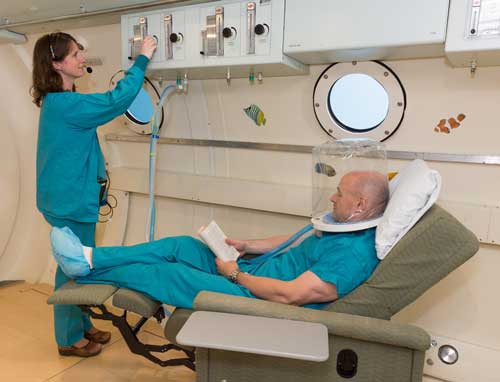
Hyperbaric oxygen therapy employs a special airtight chamber to increase the atmospheric pressure surrounding a patient (ambient pressure). The pressure may be increased several times above normal atmospheric pressure. The chamber is compressed with air while the patient breathes 100 percent oxygen. With a normal cardiovascular system, this increases the total amount of oxygen delivered to the cells by the blood stream (Henry’s law). In addition, increases in pressure result in a decrease in the size of bubbles (Boyle’s Law).
Decreasing Bubble Volume (Boyle’s Law)
Bubbles that have been formed in the body are made smaller by hyperbaric chamber pressure. Divers may acquire bubbles in their bodies when they ascend to the surface too rapidly or stay underwater too long. Divers develop a condition known as decompression sickness (the “bends”) as a result of these bubbles. Decreasing bubble size is a primary therapy for decompression sickness. Hyperbaric chamber pressure can reduce the size of these bubbles and bubbles from other sources as well.
Boyle’s law also has an effect on patients during pressurization and depressurization. During pressurization, a patient’s ears will feel full, similar to the feeling experienced when traveling in an airplane. The pressure in the ears must be relieved during pressurization and the staff employs several techniques to help patients manage this problem.
Increasing Oxygen Delivered to Cells (Henry’s Law)
Normally, most of the oxygen circulating in the body is carried by the red blood cells called hemoglobin. Hyperbaric oxygen dissolves any extra oxygen into the plasma (Henry’s law). The total oxygen carried to the tissues is about 10 times more than breathing air at sea level. The increase in the oxygen concentration in the blood stream promotes the healing of certain wounds.
Non-Healing Wounds and Infections
Hyperbaric oxygen therapy can help heal some types of wounds and infections in the following ways:
- Diabetes and radiation therapy destroy blood vessels (capillaries). Increasing oxygen to the body helps new blood vessels grow in bone or soft tissue. With this growth, more blood vessels and more oxygen rich blood can reach the affected area. Certain types of chronic wounds can also benefit in this way.
- Increased oxygen levels decrease the swelling (edema) around a wound site. Decreasing the swelling allows blood and oxygen to flow more freely to the area.
- High oxygen levels increase the ability of the ‘infection fighting’ cells (white blood cells) to kill any offending bacteria that may be in the area. This gives the wound a better chance of healing. While usually not a primary source of therapy, hyperbaric oxygen is used to treat bone infection.
- Some bacteria cannot survive at high oxygen levels. They become dormant if exposed to the high levels that can be achieved with hyperbaric oxygen therapy. This applies to gas gangrene and some of the “flesh eating” diseases.